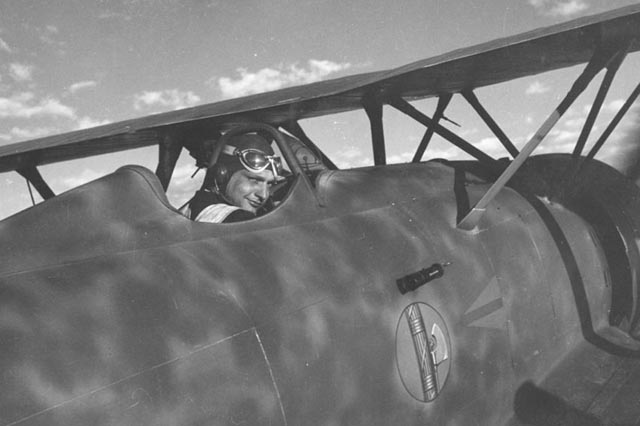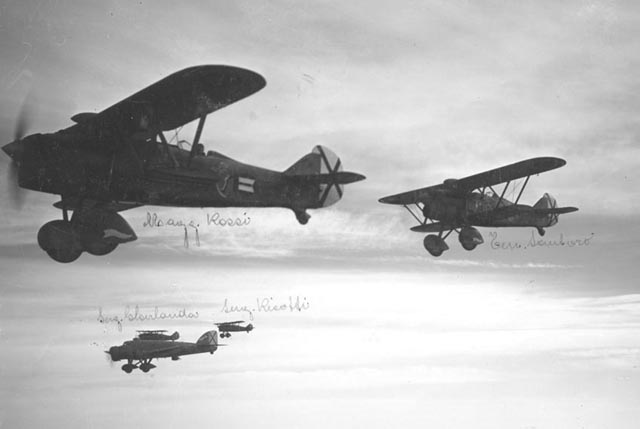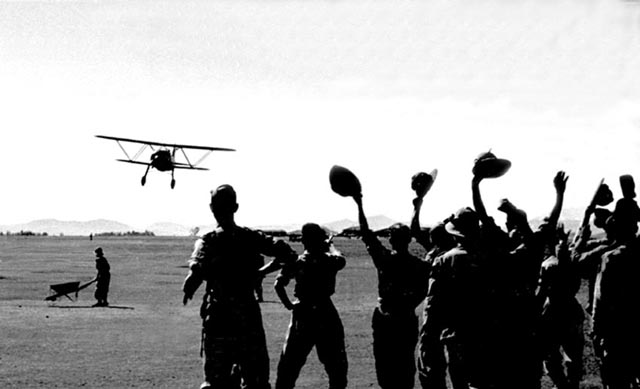Italy

Generale di Divisione Corrado Santoro
Italy

Generale di Divisione Corrado Santoro
11 November 1910 – 21 June 1988

Santoro at Diredawa, 1940.
Image kindly provided by Sergio Santoro
| Date | Decoration | Note |
| ??/??/38 | Medaglia d’argento al valor militare (1st) | O.M.S. |
| ??/??/40 | Medaglia d’argento al valor militare (2nd) | 1940-43 |
| ??/??/39 | Medaglia di bronzo al valor militare | O.M.S. |
| ??/??/?? | Croce al merito di guerra | |
| ??/??/?? | Medaglia commemorativa della campagna di Spagna (1936-1939) | O.M.S. |
| ??/??/?? | Medaglia di benemerenza per i volontari della guerra Spagna | O.M.S. |
Corrado Santoro was born on 11 November 1910 and was from Rome.
Santoro was a pre-war pilot and on 31 December 1931, he was promoted to Tenente di complemento.
On 31 December 1935, he was promoted to Tenente in spe (servizio permanente effettivo).
Between 10 October 1937 and 14 July 1938, he served as a volunteer in the Aviazione Legionaria in Spain using the nom de guerre 'Corrado Salvioli'. Here he belonged to the 31a Squadriglia Caccia under the command of Capitano Baylon.
On 10 December and in order to camouflage a planned Nationalist offensive towards Madrid on the Guadalajara, the Republican air forces were to be destroyed on their airfields east of Zaragoza. A Nationalist force of 88 bombers and 56 fighters took part in the operation. The slower bombers (SM.81s and Ju 52/3ms) were to attack the nearby airfields in the Barbastro zone; the faster bombers (SM.79s, Breguet 20s, He 111s and Do 17s) those at Sariñena, Bujaraloz, Candasnos, Puebla de Híjar, Selgua, Pomar, Lérida and Balaguer. The Condor Legion’s bombers, which had to operate from more distant bases, would require refuelling before making their return flight, and facilities were provided at Sanjurjo.
The attacks failed to achieve the desired success, however; the airfields were empty and about 70 fighters were waiting in the air. It must be said that the Republicans were very well prepared to deal with surprise air attacks. They had constructed a large number of airfields and at each was based at most a single squadron, its aircraft widely dispersed around the airfield perimeter. In addition, they had built a number of decoy airfield on with mock-up aircraft.
At least, the VI and XVI Gruppi of the Aviazione Legionaria took part in this combat and Tenente Santoro of the 31a Squadriglia (VI Gruppo) took part in an escort mission to bombers attacking Sariñena and Sottotenente Mario Visintini of the 25a Squadriglia (XVI Gruppo) took part in his first combat, firing at some enemy aircraft but without claiming anything.
At the end of the battle, the Italians claimed eight I-15s shot down for just one CR.32 lost and its pilot KIA when Sottotenente Vittorio Barberis of the 32a Squadriglia, was killed in action near Alcubierre when his CR.32 collided with I-15 CC-022, flown by Soviet pilot Mikhail Vasilhevich Kotyhov from the 1a/26. The latter pilot also perished.
Group 2-G-3, which was flying below the Italians, climbed to their assistance and claimed seven I-15s without losses.
1.J/88 was airborne, with 15 Bf 109s flying deep into enemy territory. They were attacked by 30 enemy fighters. Oberleutnant Harro Harder recounted:
”Another major action on December 10. The Fiats patrolled the front, we flew deep into enemy territory with fifteen Bf 109s. Fifteen Curtisses and fifteen Ratas climbed up in close formation. There was nothing else to do, we attacked repeatedly, but so many aircraft immediately dove on us that we were happy just to escape in one piece.”The German fighters didn’t claim anything during the day.
On 4 January 1938, XXIII Gruppo Caccia, based at Bello, went into action over Teruel during the early afternoon when 24 CR.32s of its three squadriglie, led by Maggiore Andrea Zotti, intercepted a formation of nine R-Zs from 2a Escuadrilla of Grupo No 30, and their escort of 13 I-15s and 15 I-16s.
The Italian pilots claimed four light bombers destroyed, two of the aircraft crashing in Republican territory and a third coming down in flames onto the beach at Malvarosa, close to Sagunto. Two more battle-damaged R-Zs landed back at their Liria base. The Italian pilots then turned their attention to the bombers’ fighter escort when a second R-Z escuadrilla aborted its attack so as to escape the marauding CR.32s.
During a frontal clash in broken cloud, Maggiore Zotti shot down the I-15 flown by patrol leader leitenant Josef Kapustin of 1a/26. The latter managed to parachute into Republican territory. The Italian ace’s aircraft had in turn been hit by seven rounds fired by Kapustin as he flew headlong at the CR.32.
It’s possible that the VI Gruppo also took part in this mission since Tenente Santoro of the 31a Squadriglia is recorded to having taken part in a mission escorting bombers over Teruel.
The Republicans reported that an aerial battle took place over the front line near Teruel when two escuadrillas of R-Zs aircraft (16 machines), 15 I-16s, and 13 I-15s were engaged with CR.32s and He 111s. The Nationalist bombers and one R-Z escuadrilla returned without completing their mission while the remaining aircraft became involved in a fierce skirmish.
One R-Z was shot down but the crew parachuted to safely. Another R-Z sustained serious damage and crashed during landing, with the gunner killed. Josef Kapustin’s (1a/26) I-15 was shot down, but he survived. Sergey Zubarov's I-16 was damaged, and it crashed during landing at Montoro airfield.
The Republicans claimed two CR.32s shot down, one of which fell on Republican territory.
On 8 June, he took part in an escort mission to bombers attacking Vistabella Choclos. 11 enemy aircraft was claimed shared destroyed (probably on the ground) by 22 Italian pilots.

Image taking during an escort to bombers over Spain.
Leading the formation is Maggiore Rossi and Santoro is flying in the CR.32 behind him.
Image kindly provided by Sergio Santoro
Santoro was promoted to Capitano on 31 December 1938.
On 8 April 1940 he was posted to the Italian East Africa (A.O.I.) as Commanding Officer of the 413a Squadriglia.
In June 1940, the 413a Squadriglia was based at Gondar in Ethiopia and equipped with Fiat CR.42s.
On 22 June, one Ro.37bis piloted by Colonnello Mario Pezzi, one CR.32 piloted by Capitano Corrado Ricci, and equipped with bomb throwers for two 25 kg and thirteen 2 kg bombs, four more Ro.37bis of the 110a Squadriglia and three CR.42 of the 413a Squadriglia took off from Dire Dawa and carried out a strafing and dive-bombing attack of the airfield of Djibouti. The formation took off at 05:40 and landed back at 08:30 (according with other sources, the CR.42 were four and the time was 07:00-11:00, the latter time is consistent only with the endurance of the Ro 37bis). On landing back, the Ro.37bis MM 10767 crash-landed overturning and was declared RD; the pilot was unhurt.
Three aircraft, believed being French, suddenly attacked Dire Dawa at 13:30 (12:15 according to the 410a diary), favored by bad weather.
Sottotenente Miroslav Komjanc tried to scramble, but his aircraft was hit and burned by a bomb before he could mount in it; he was luckily unhurt. The other pilot on alarm duty, Sergente Maggiore Gaetano Volpe of the 410a Squadriglia, was taking off, but a splinter stopped him by damaging the engine of his CR.32 MM4648. Another fighter was damaged, one of ground personnel was killed and two wounded. Capitano Ricci, CO of the 410a Squadriglia, recalled the episode:
“…We couldn’t start to have our lunch that a bomb rain, damned close, hurries us: who runs to recovery, who lies on ground, … windows glass shatters and breaks, roof vibrates and a rain of debris and powder covers us and our maccheroni, floor shatters and it seems that explosions never end.
Santoro is on the ground beside me, we’re flat as soles as we look on one another, while the hell continues: we’re both pale… As soon the explosions cease we jump up and run to the airport. There had been three bombers, absolutely unexpected: a driver is dead, hit by a splinter; Colonnello Pezzi shows me it, a few grams of iron, and says: “For this small bit of damned iron a life has gone… and I’ll have to write this to his mother!”
Two more airmen have been slightly wounded, a fighter burns at the end of the field, the oil sump of my engine has been penetrated from side to side. Sottotenente Komjanc was on alarm duty and was running towards his CR.42, which his engineer had soon started. While he was wearing his parachute, some bombs dropped nearby and the shock wave threw him on ground. As he rose up, he saw his fighter burning: he’s now telling this to Santoro, and he’s desperate for having lost an aircraft. It seems he still doesn’t realize of the extraordinary luck that protected him!”
Early in the morning on 20 August four Blenheims of 39 Squadron and one of 11 Squadron, RAF, attacked the Ala Littoria hangar at Diredawa. This target was hit and damaged; a S.81 under repair being burnt and splinters damaged a CR.32. While on the run-up to the target the bombers were attacked by two CR.42s of the 413a Squadriglia and 20-year-old Pilot Officer Paul Edwin Osborne Jago’s (RAF No. 40916) Blenheim Mk.I (L8474) was shot down in flames by Capitano Santoro, the crew being killed (Pilot Officer Jago, Sergeant John Astil Wilson-Law (RAF No. 580723) and Corporal John Herbert Wintle (RAF No. 519946)). Santoro also hit the 11 Squadron aircraft, which was badly damaged and crash-landed on return to Aden. Santoro's CR.42 was hit in the fuselage during this combat.

Santoro returning to Diredawa after his combat on 20 August 1940.
Image kindly provided by Sergio Santoro
Santoro managed to be evacuated from East Africa before it fell to the Commonwealth forces.
On 17 August 1941 he took command of the 370a Squadriglia Caccia, which was based at Monserrato near Cagliari, Sardegna (Sardinia).
In September the 24o Gruppo was equipped with Fiat G.50s and CR.42s. The biplanes were used for long-distance missions due to better range.
At 08:18 on 27 September 1941 an Italian reconnaissance aircraft spotted a carrier and seven unidentified ships west of La Galite. Towards noon, the Comando Aeronautica della Sardegna received the following message from a Cant Z.506 of 287a Squadriglia (Sottotente Giovanni Del Vento in MM45252):
"At 37o43' – 8o55' - route 90o - speed 12 nm per hour: 1 battleship, 1 carrier, 4 cruiser, unspecified number of destroyers and steamboats. At 37o55' - 8o45' - route 90o - speed 18 nm per hours: 3 cruisers"It was the convoy of Operation Halberd which included the carrier HMS Ark Royal, three battleships (HMS Prince of Wales, HMS Rodney and HMS Nelson), five cruisers (HMS Kenya, HMS Edinburgh, HMS Sheffield, HMS Hermione and HMS Euryalus), eighteen destroyers (Lance, Isaac Sweers, Gurkha, Duncan, Garland, Livery, Heytrop, Fury, Zulu, Cossack, Foresight, Forester, Laforey, Farndale, Lightning, Oribi, Piorun and Legion) and nine cargos (Ajax, Clan MacDonald, Imperial Star, Rowallan Castle, City of Calcutta, Clan Ferguson, Dunedin Star, Breconshire and City of Lincoln).
On 20 March 1942, four boats of the 3rd Motor Launches Flotilla (ML126, ML129, ML130 and ML132) left Gibraltar towards Malta. The following day they were spotted by an Italian recon aircraft.
At 11:50 on 21 March, six CR.42s of the 24o Gruppo took off from Monserrato led by Capitano Alberto Brondi (CO of the 355a Squadriglia) and armed with bombs. As they found the boats in the Gulf of Bona, they dive-bombed them. The CR.42s didn’t score any direct hits due to evasive manoeuvres by the boats, but the bombs exploded close to their targets and damaged two of them. The CR.42s then strafed the boats before returning and landing safely at 15:10.
At 15:30, Capitano Santoro took off with six CR.42s (Tenente Giorgio Moretti and Tenente Francesco Rocca of the 354a Squadriglia, Sottotenente Franco Mazzariol and Sergente Maggiore Edoardo Lion of the 355a Squadriglia and Sottotenente Renato Luziani of the 370a Squadriglia).
They found two of the motor-boats (ML129 and ML132), which probably had been damaged by the previous attack. As they strafed them, ML129 exploded and sunk, while ML132 reached the Tunisian coasts and stopped near the Bona pier.
Santoro’s aircraft was hit in the engine by defensive fire and he had to land at Bona. The others landed safely at 18:15.
Italians claimed a boat sunk and another damaged. Actually, ML132 was so damaged that it was declared damaged beyond repair.
On 15 July he took part in dive bombing of an enemy cruiser sailing at 37o 23’ lat and 8o 25’ long.
On 13 November 1942 Santoro was promoted to Maggiore.
Santoro left the command of the 370a Squadriglia on 31 March 1943.
Santoro ended the war with 4 victories, these being claimed while flying Fiat CR.42s.
During his career he received two promotions on war merits.
Santoro remained in the Air Force after the war and was promoted to Tenente Colonnello on 1 December 1945.
On 31 August 1953 he was promoted to Colonnello.
Between 1955 and 1956 he served as Commander of the 4th Aerobrigata.
He was promoted to General di Brigata on 31 December 1961.
When he retired he was promoted to Generale di Divisione.
Santoro passed away in Frascati (Rome) on 21 June 1988.
Claims:
| Kill no. | Date | Time | Number | Type | Result | Plane type | Serial no. | Locality | Unit |
| 1940 | |||||||||
| 1 | 20/08/40 | 1 | Blenheim (a) | Destroyed | Fiat CR.42 | Diredawa | 413a Squadriglia | ||
| 20/08/40 | 1 | Blenheim (b) | Damaged | Fiat CR.42 | Diredawa | 413a Squadriglia | |||
| 1941 | |||||||||
| 2 | 27/09/41 | 1 | Hurricane (c) | Destroyed | Fiat CR.42 | 200km off Sardinia | 370a Squadriglia | ||
| 3 | 27/09/41 | 1 | Hurricane (c) | Destroyed | Fiat CR.42 | 200km off Sardinia | 370a Squadriglia | ||
| 4 | 27/09/41 | 1 | Hurricane (c) | Destroyed | Fiat CR.42 | 200km off Sardinia | 370a Squadriglia | ||
| 27/09/41 | 1 | Hurricane (c) | Probable | Fiat CR.42 | 200km off Sardinia | 370a Squadriglia | |||
| 27/09/41 | 1 | Hurricane (c) | Probable | Fiat CR.42 | 200km off Sardinia | 370a Squadriglia | |||
| 27/09/41 | 1 | Hurricane (c) | Probable | Fiat CR.42 | 200km off Sardinia | 370a Squadriglia | |||
| 1942 | |||||||||
| 21/03/42 | 1 | Torpedo boat (d) | Shared destroyed on the water | Fiat CR.42 | Gulf of Bona | 370a Squadriglia | |||
| 21/03/42 | 1 | Torpedo boat (d) | Shared destroyed on the water | Fiat CR.42 | Gulf of Bona | 370a Squadriglia |
Biplane victories: 4 destroyed, 3 probably destroyed, 1 damaged, 2 shared destroyed on the water.
TOTAL: 4 destroyed, 3 probably destroyed, 1 damaged, 2 shared destroyed on the water.
(a) Blenheim L8474 of 39 Squadron shot down. The pilot Pilot Officer P. E. O. Jago and his crew killed.
(b) Blenheim of 11 Squadron badly damaged and crash-landed on return.
(c) Claimed in combat with Fulmars from HMS Ark Royal which lost two Fulmars from 808 Squadron, reportedly shot down by friendly AA fire. Only claimed in his logbook. According to other sources Santoro only claimed two Hurricanes.
(d) ML129 and ML132 of the 3rd Motor Launches Flotilla sunk.
Sources:
Luciano Cacciavillani's personal logbook courtesy of Cacciavillani family (Luciano jr and Alberto)
36o Stormo, Storia fotografica 1938-1996 - Carlo Lucchini, 1996 Giorgio Apostolo Editore, 2nd edition, Milan, kindly provided by Stefano Lazzaro.
410a Squadriglia war diary (1940) kindly provided by Stefano Lazzaro.
Aerial War in Spain: Chronicle of air battle 1936-1939 – Sergey Abrosov, 2008
Buscaglia e gli Aerosiluranti - Orazio Giuffrida, 1994 Ufficio Storico Aeronautica Militare, Rome, kindly provided by Stefano Lazzaro.
Dust Clouds in the Middle East - Christopher Shores, 1996 Grub Street, London, ISBN 1-898697-37-X
Elenco Nominativo dei Militari dell' A. M. Decorati al V. M. Durante it Periodo 1929 - 1945 2 Volume M - Z
Il contrasto aereo italiano all'operazione "Halberd" - Antonio Maraziti, 2003 Storia Militare no. 115 (XI), April 2003 kindly provided by Stefano Lazzaro.
Inferno su Malta - Nicola Malizia, 1976 Mursia, Milan, kindly provided by Stefano Lazzaro.
L'Aeronautica Italiana nella Seconda Guerra Mondiale - Prima Parte - Giuseppe Santoro, 1950 Danesi, Rome, kindly provided by Stefano Lazzaro.
La Regia Aeronautica 1939-1943, Vol. II: 1942, L'anno della riscossa - Nino Arena, 1982 Ufficio Storico Aeronautica Militare, Rome, kindly provided by Stefano Lazzaro.
Storia degli Aerosiluranti Italiani - Carlo Unia, 1974 Edizioni Bizzarri, Rome, kindly provided by Stefano Lazzaro.
The Commonwealth War Graves Commission
Un aviatore racconta le sue battaglie 1940-1943 - Francesco Aurelio Di Bella, 1950 Renna, Palermo kindly provided by Stefano Lazzaro.
Most information kindly provided by Stefano Lazzaro Michele Palermo, Sergio Santoro and Ludovico Slongo.


